- Home
- Robert J. Sawyer
Hybrids Page 17
Hybrids Read online
Page 17
“I think we’ll be happy to just try our luck randomly.” The words were out before Mary really had time to think about them; perhaps, she realized, it was some of her natural Catholic revulsion at tinkering with the stuff of life coming to the surface...althoughany use of this machine certainly qualified as major tinkering!
Vissan frowned. “If you were both Barasts, I would be content to accept that answer-but then again, as you yourself observed, Mare, if you were both Barast, you wouldn’t need the codon writer just to randomly combine your genetic material.” She shook her head. “But you are not both Barasts.” She looked down at Ponter’s forearm. “I never thought I’d use one of these again, but...Companion of Ponter!”
“Healthy day,” said a male voice from the device’s external speaker. “My name is Hak.”
“Hak, then,” said Vissan. “Surely studies have been done of the differences between Barasts and Gliksin deoxyribonucleic acid since contact was made with Mare’s people?”
“Oh, yes,” said Hak. “It has been quite the hot topic.”
“Are those studies available through the planetary information network?”
“Of course.”
“Good,” said Vissan. “We will need to access them as we go along.” She looked up and shifted her gaze from Mary to Ponter, then back to Mary again. “I strongly advise against just slapping your deoxyribonucleic acid together. We are talking about combining two species here. Now, yes”-she gestured at the codon writer’s screen-“it’s clear that the genomes for Barasts and Gliksins are almost identical, but we should really examine where they diverge, and carefully select combinations.” She pointed at Mary. “Are tiny noses like that typical of your species?”
Mary nodded.
“Well, there, you see? It would be ridiculous to code for a tiny Gliksin nose and a giant Barast olfactory bulb. Traits should be chosen with care so that they enhance, or at least do not interfere with, each other.”
Mary nodded. “Right. Of course.” Butterflies were pirouetting in her stomach, but she tried to sound jaunty. “So, what’s on the menu?”
“Hak?” said Vissan.
“The genetic divergence-“
“Wait!” said Vissan. “I haven’t asked you a question yet.”
Ponter smiled. “Hak is a very intelligent Companion,” he said. “Do you know Kobast Ganst?”
“The artificial-intelligence researcher?” said Vissan. “I knowof him.”
“Well,” said Ponter, “about ten months ago, he upgraded my Companion. You weren’t the only one trying to improve the lot of Barasts, of course. Kobast wants everyone in generation 149 to have the benefit of truly intelligent Companions.”
“Well, let’s hope they don’t shut Ganst’s work down as well-although if they do, I’ll be happy to have a neighbor. In any event, I was about to ask Hak to summarize what is known about how the Gliksin genome differs from the Barast one.”
“And I was about to tell you,” said Hak, sounding slightly miffed. “There are, as you observed, about 50,000 active genes in any Gliksin or Barast. But 98.7% of those have allele forms that exist in both populations; only 462 genes have forms that exist in Barasts but not in Gliksin, or vice versa.”
“Fine,” said Vissan. She looked at Mary. “You can leave the rest to chance, if you like, but I really think we should carefully look at those 462 genes, and make sensible choices for each of them.”
Mary looked at Ponter, to see if he had any objection. “That’s fine,” she said.
“All right-although, before we start, there are two big questions we must resolve. With the codon writer, we will make a diploid set of chromosomes combining deoxyribonucleic acid from both of you. Do we make twenty-three pairs of chromosomes, or twenty-four? That is, at the level of the chromosome count, do you want your child to be a Barast or a Gliksin?”
“Wow,” said Mary. “That’s a good question. The work I did in my world was about defining which species a person belongs to for immigration purposes. It seems likely that chromosome count will be adopted as the legal standard.”
“Your child can be a hybrid in many ways,” said Vissan. “But in this, it must be one or the other.”
“Um, gee...Ponter?”
“You are the geneticist, Mare. I rather suspect that matters of chromosome count are-how would you put it?-‘nearer and dearer to your heart’ than they are to mine.”
“You don’t have a preference?”
“Not on an emotional level, no. I suspect, though, that there are legal advantages to making our child genetically Gliksin.”
“How so?”
“We have a unified world government-the High Gray Council. You have 191 member states in your United Nations, plus some more besides that are not members, and immigration issues will arise with each of them, no?”
Mary nodded.
“It seems easier to convince one world government that a being with twenty-three pairs of chromosomes should be able to live and work anywhere in my world than it will be to convince some 200 governments in your world that a being with twenty-four pairs of chromosomes should be accorded the same rights.”
Mary looked at Vissan. “We’re not actually going to manufacture the DNA for our child today, right?”
“No, no, of course not. That will be done back in your world, I presume, when you are ready to become pregnant. I am just taking you through the issues you must deal with.”
“So we don’t have to decide right now.”
“That is correct.”
“Well, then, let’s table that one.”
Vissan looked at the table in front of her. “Pardon?”
“I mean, let’s set it aside for now. What’s next?”
“Well, this has nothing to do with your special circumstances but must also be decided, since it affects how the codon writer apportions Ponter’s deoxyribonucleic acid. Do you want a boy or a girl?”
“We’ve already discussed that,” said Mary. “We’re going to have a daughter.”
Vissan touched a control on the codon writer. “A girl it is,” she said. “Now, let’s see what else we’ve got...” She looked at the display.
“The next gene sequence displayed,” said Hak, “refers to hair part. Barasts have a natural part along the centerline of the scalp, right above the sagittal suture. Gliksins tend to have natural parts off to the sides. Mary seems to have alleles only for side parts; both alleles from Ponter’s personal genome are, of course, for center parts. You could take one of each, and discover experimentally which is dominant, or you could take both of Ponter’s and neither of Mare’s, or both of Mare’s and neither of Ponter’s, and be reasonably sure of the outcome.”
Mary looked at Ponter. The Neanderthals did indeed part their hair like bonobo chimpanzees. At first she’d found it quite startling, but she’d since gotten used to it. “I don’t know.”
“The side,” said Ponter. “If she is going to be a girl, she should take after her mother.”
“Are you sure?” asked Mary.
“Of course.”
“The side then,” said Mary. “Use both of my alleles.”
“Done,” said Vissan, touching some more controls. She indicated the square display. “You see how it’s done? These touch-points on the screen select alleles?”
Mary nodded. “Quite straightforward.”
“Thank you,” said Vissan. “I worked hard to make it easy to use. Now, I recognize the next group of alleles, at least on Ponter’s side: they are for eye color. Mare, your eyes are blue-something we never see here. Ponter’s are a golden brown shade we calldelint ; it is uncommon, but prized all the more because of that.”
“Blue eyes are recessive in Gliksins,” said Mary.
“As aredelint here. So we can either take both your alleles, and make your daughter blue-eyed, both of Ponter’s and make her golden-eyed, or throw in one of each and be surprised by the outcome...”
They continued on in that vein for quite some time, interrupted only by Mary
, then Ponter, having to take bathroom breaks-meaning using a wooden chamber pot.
“And now,” said Vissan, “we come to an interesting neurological item. I’d be very reluctant to take one of Mare’s alleles and one of Ponter’s at this point, since we just don’t know what effect mixing them at this site will have. I think it would be much safer for the child to go all one way or all the other, rather than try to blend the characteristics. In a Barast, this gene is well known for governing development of the part of the brain’s parietal lobe that is located in the left hemisphere. You surely don’t want to risk brain damage, and-“
“Did you say the parietal lobe?” said Mary, leaning forward. Her heart was pounding.
“Yes,” said Vissan. “Now, if that doesn’t form properly, aphasia can result, as can difficulties with motor function, so-“
Mary turned on Ponter. “Did you put her up to this?”
“I beg your pardon?” said Ponter.
“Come on, Ponter. The part of the parietal lobe in the left hemisphere!”
Ponter frowned. “Yes?”
“It’s what Veronica Shannon said is responsible for religious thinking in my kind of people. The out-of-body experience; the sense of being at one with the universe. All of that is rooted there.”
“Oh,” said Ponter. “Right.”
“You mean to say you didn’t know this was going to come up?”
“Honestly, Mare, I had no idea.”
Mary looked away. “You’ve been talking about a ‘cure’ for religion, for Pete’s sake. And now, lo and behold, we have one.”
“Mare,” said Vissan, “Ponter and I did not discuss this in advance.”
“No? You were alone together hunting long enough...”
“Really, Mare,” said Vissan, “I am not aware of the research you mentioned.”
Mary took a deep breath, then let it out very slowly. “I’m sorry,” she said at last. “I should know better. Ponter would never blindside me.”
Ponter’s Companion bleeped, but he didn’t ask for an explanation.
Mary reached out with her left hand. “Ponter, youare my man-mate, even if we haven’t yet undergone the bonding ceremony. I know you would never deceive me.”
Ponter said nothing.
Mary shook her head. “I didn’t expect to have to face this issue. I mean, eye color and hair color, sure. But atheist or believer? Who’d have thought that that would be a genetic choice?”
Ponter squeezed Mary’s hand. “This issue is far more significant to you than it is to me. I understand that much, at least. We will do whatever you wish.”
Mary took another deep breath. She could talk it over with Father Caldicott, she supposed-but, geez, a Roman Catholic priest wouldn’t approve ofany part of this process. “I’m not blind, you know,” said Mary. “I’ve seen how peaceful this world of yours is, at least most of the time. And I’ve seen how...” She trailed off, thought for a moment, then shrugged, finding no better word than the one that had first occurred to her “...howspiritual your people are. And I keep thinking about all the things you’ve said, Ponter-back at Reuben’s place, when we watched that Roman Catholic Mass together on TV, and at the Vietnam veterans’ wall, and...” She shrugged again. “Ihave been listening, but...”
“But you’re not convinced,” said Ponter gently. “I don’t blame you. After all, I am no sociologist. My musings about the”-he, too, paused, clearly aware that this was a most delicate topic right now, but then he went on, also, apparently, unable to find a better word-“evil that religion has caused in your world are just that: musings, philosophical ramblings. I can’t prove my case; I doubt anyone could.”
Mary closed her eyes. She wanted to pray, to ask for guidance. But none had ever come in the past; there was no reason to think this time would be different. “Maybe,” she said at last, “we should simply leave it up to fate; let the genes fall where they may.”
Vissan’s voice was soft. “If this involved any other part of the body, I might agree with you, Mare. But we’re talking about a component of the brain that is demonstrably different between the two species of humanity. To simply throw together one allele from a Gliksin and another from a Barast, then just hope for the best hardly seems prudent.”
Mary frowned, but Vissan was right. If they were going to go ahead with having a hybrid child, a decision had to be made, one way or the other.
Ponter let go of Mary’s hand, but then started stroking its back. “It’s not,” he said, “as if we are choosing whether or not our daughter will have a soul. At most, we’re choosing whether or not she willbelieve she has a soul.”
“You do not have to decide this today,” said Vissan. “My intent, as I said, is only to walk you through the process of using the codon writer. You won’t want to produce the diploid chromosome set until it is time for it to be implanted in you, anyway, Mare.” She folded her hands. “But when that time comes, youwill have to make this choice.”
Chapter Twenty-five
“So, yes, indeed, now is the time to take longer strides. But it’s not just time for a great new American enterprise. Rather, it’s time, if I may echo another speech, for black men and white men, Jews and Gentiles, Protestants and Catholics-and Hindus and Muslims and Buddhists, and men and women of all faiths, and men and women of none-for individuals from every one of our 191 united nations, for members of every race and religion that make up our unique, varied brand of humanity-to go forward together, in peace and harmony, with mutual respect and friendship, continuing the journey weHomo sapienshad briefly interrupted...”
“I think,” said Vissan, “that the two of you have some things to discuss. Perhaps I will take Mega, and we will go look at the stars.” Mega had roused from her nap. “Would you like that, Mega?”
“Sure!” said Mega.
Vissan got up from her chair, found her fur coat, wrapped Mega in a couple of oversized shirts, and they headed for the door.
Mary felt a cold wind on her face as the door swung open. She watched Vissan and Mega leave, the wooden door closing behind them.
“Mare...” said Ponter.
“No, no, let me think,” said Mary. “Just let me think for a few minutes.”
Ponter shrugged amiably, headed over to Vissan’s stone fireplace, and set about making a fire.
Mary got up off the vacuum box, and took Vissan’s vacated seat, resting her chin on her hand.
Herchin...
AHomo sapiens trait.
But a trivial one, completely unimportant.
Mary sighed. Except for the question of living arrangements, she didn’t care if they had a boy or a girl.
And she certainly didn’t care where their child parted her hair. Or what color her eyes were. Or whether she was muscled like a Neanderthal. Or what sort of sense of smell she had.
As long as she’s healthy...
That had been the mantra of parents for millennia.
Except in Veronica’s lab, Mary had never had a full-blown religious experience, but nonetheless she really did believe in God. Even now, knowing that her predisposition to such belief was hardwired into her brain, she still really did believe.
Did she want to deny their daughter the comfort that went with that belief? Did she want to prevent her from ever knowing the religious rapture that had eluded Mary outside of that lab but had apparently touched so many others?
She thought about this world she was in, and rhetoric from the newscasts of her youth welled up in her mind. Words she’d avoided until now.
Godless people.
Communists.
But, damn it all, the Neanderthal systemworked . It worked better than the corrupt, morally bankrupt capitalism of her world-the world of Big Tobacco and Enron and WorldCom and all the others that had been exposed since, people driven by nothing but greed, taking obscene amounts for themselves while others ended up without even enough food to eat.
And it worked better than the religious institutions of her world-her own
Church sheltering child abusers for decades, her religion and so many others oppressing women, religious fanatics flying planes into skyscrapers...
Ponter was making progress with the fire. Wisps of smoke were rising from the logs he’d placed atop the stones within the fireplace.
At last, when he’d fanned the flames to vigorous life, Mary got up from the chair and walked over to her man, still crouching by the hearth.
He looked up at her, and although the light from the fire threw his browridge and massive nose into sharp relief, he still looked loving and gentle. “I will accept whatever choice you make,” he said, rising to his feet.
Mary put her arms around his shoulders. “I-I wish I could think about this for a good long time.”
“There issome time,” said Ponter. “But a finite amount. If our child is to be part of generation 149, she must be conceived on schedule.”
Mary knew her voice sounded petulant. “Maybe she won’t be part of 149. Maybe we’ll have her the following year. Or the year after that.”
Ponter’s tone was soft. “I know that your people give birth every year. If our child will be principally raised in your world, then it does not matter when she is conceived. But if we wish her to be raised in whole or in part in this world, or ever really to have the option of fitting in to this society, then it really must be done on schedule.”
“It,” said Mary, pulling back, looking at Ponter.
Ponter’s eyebrow went up.
“It,” Mary repeated. “’It must be done on schedule.’ Hardly sounds romantic.”
Ponter drew her close again. “We face a few...special challenges. But what could be more romantic than the child of people who are in love?”
Mary forced a smile. “You’re right, of course. Sorry.” She paused. “And you’re right that we should do it at the correct time.” Mary’s own birthday was late in the year; she knew what it was like to be even six months younger than some of the other kids on the school playground. She couldn’t imagine how devastating it would feel to be a year or two younger than everyone else. Yes, their daughter would be raised principally in Mary’s world, but when she was all grown up, she might choose to make her home in the Neanderthal universe-and she would never fit in here if she wasn’t part of a specific generation.

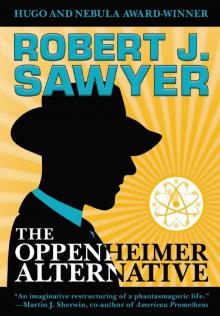 The Oppenheimer Alternative
The Oppenheimer Alternative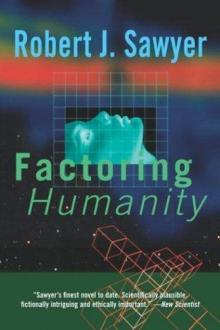 Factoring Humanity
Factoring Humanity The Shoulders of Giants
The Shoulders of Giants Stream of Consciousness
Stream of Consciousness End of an Era
End of an Era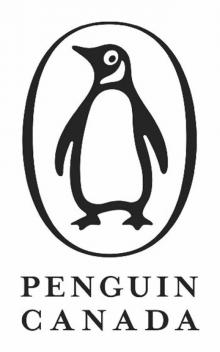 The Terminal Experiment
The Terminal Experiment Far-Seer
Far-Seer Mindscan
Mindscan You See But You Do Not Observe
You See But You Do Not Observe Star Light, Star Bright
Star Light, Star Bright Wonder
Wonder Wiping Out
Wiping Out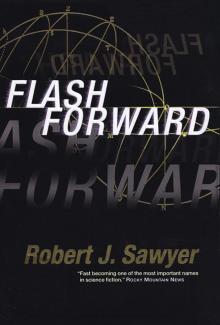 Flashforward
Flashforward Above It All
Above It All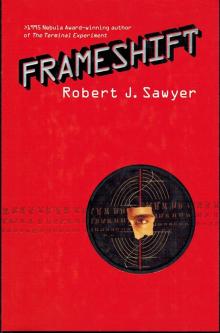 Frameshift
Frameshift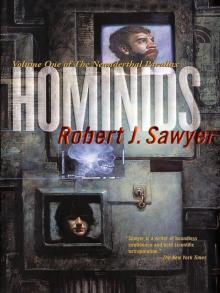 The Neanderthal Parallax, Book One - Hominids
The Neanderthal Parallax, Book One - Hominids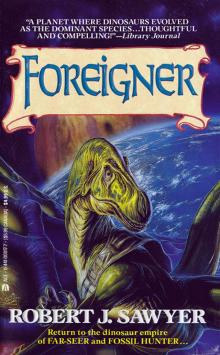 Foreigner
Foreigner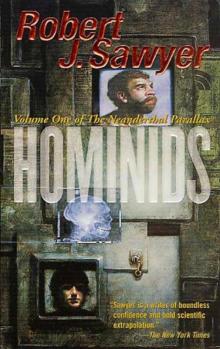 Neanderthal Parallax 1 - Hominids
Neanderthal Parallax 1 - Hominids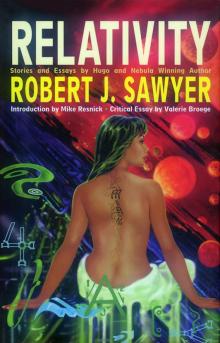 Relativity
Relativity Identity Theft
Identity Theft Hybrids np-3
Hybrids np-3 Foreigner qa-3
Foreigner qa-3 WWW: Watch
WWW: Watch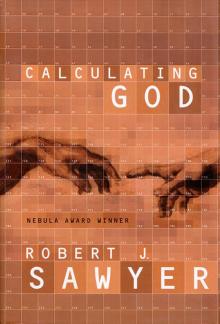 Calculating God
Calculating God The Terminal Experiment (v5)
The Terminal Experiment (v5) Peking Man
Peking Man The Hand You're Dealt
The Hand You're Dealt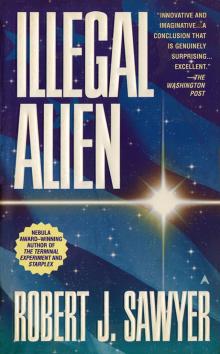 Illegal Alien
Illegal Alien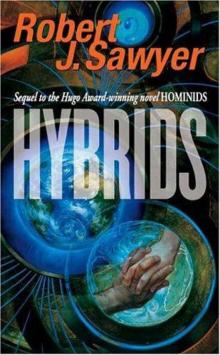 Neanderthal Parallax 3 - Hybrids
Neanderthal Parallax 3 - Hybrids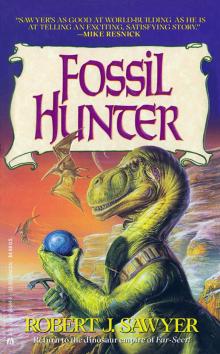 Fossil Hunter
Fossil Hunter WWW: Wonder
WWW: Wonder Iterations
Iterations Red Planet Blues
Red Planet Blues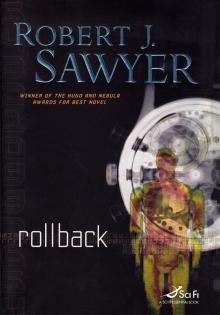 Rollback
Rollback Watch w-2
Watch w-2 Gator
Gator Triggers
Triggers Neanderthal Parallax 2 - Humans
Neanderthal Parallax 2 - Humans Wonder w-3
Wonder w-3 Wake
Wake Just Like Old Times
Just Like Old Times Wake w-1
Wake w-1 Fallen Angel
Fallen Angel Hybrids
Hybrids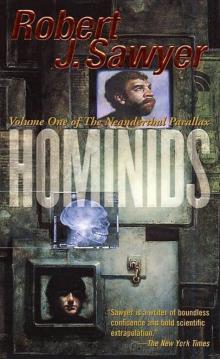 Hominids tnp-1
Hominids tnp-1 Far-Seer qa-1
Far-Seer qa-1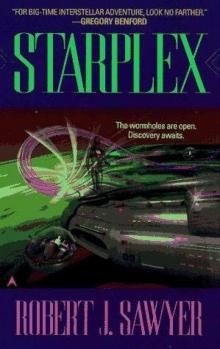 Starplex
Starplex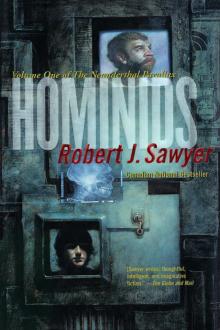 Hominids
Hominids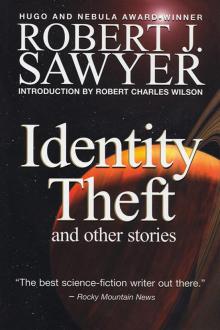 Identity Theft and Other Stories
Identity Theft and Other Stories Watch
Watch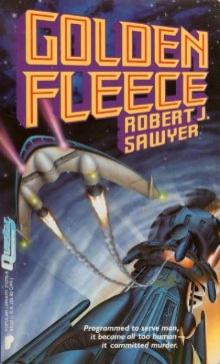 Golden Fleece
Golden Fleece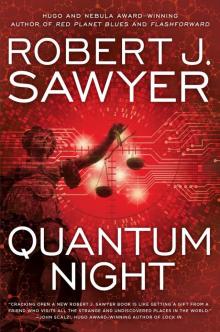 Quantum Night
Quantum Night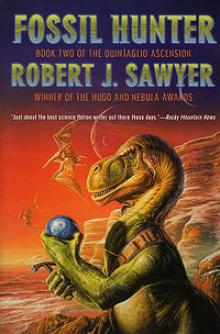 Fossil Hunter qa-2
Fossil Hunter qa-2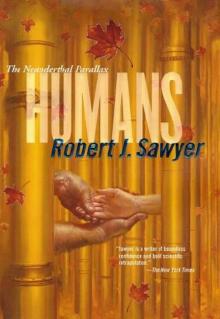 Humans np-2
Humans np-2 Biding Time
Biding Time